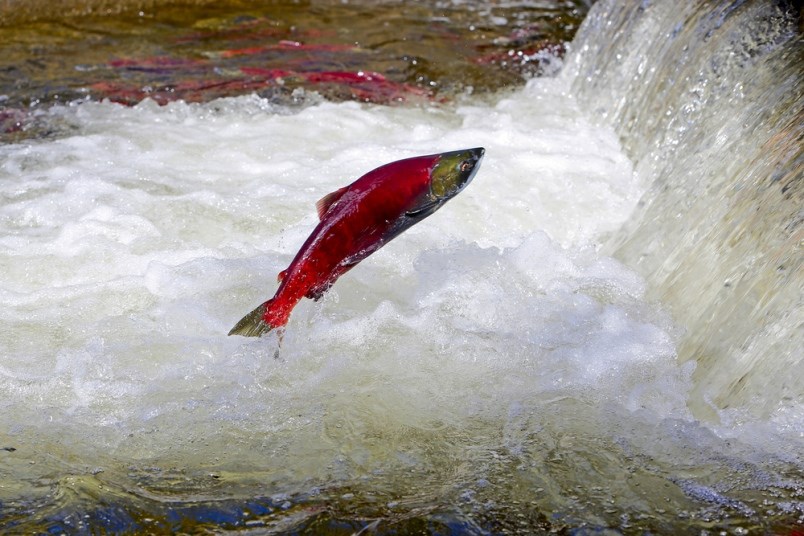The Federal Court of Appeal has ruled that Fisheries and Oceans Canada did not properly consult the Squamish Nation when it denied a requested increase in their allowance for sockeye salmon.
Fisheries and Oceans Canada – then known as the Department of Fisheries and Oceans (DFO) – denied the Squamish Nation’s request to increase their allowance for Fraser sockeye salmon from 20,000 to 70,000 in 2014, and the Squamish Nation asked for a judicial review of the decision. The Federal Court denied that review in 2017 and the Squamish Nation appealed to the Federal Court of Appeal, which ruled on the case earlier this month.
In an Aug. 8 document from the appeal, Justice of Appeal Eleanor Dawson wrote: “I find that the Federal Court erred. Specifically, Squamish’s request for an increase in its allocation triggered the duty to consult, the duty owed was not at the low end of the consultation spectrum and the duty to consult was not reasonably and adequately discharged.”
Dawson outlines that the Policy for the Management of Aboriginal Fishing states DFO must consult with Indigenous people if decisions or action may affect Indigenous fishing rights to catch for food, social and ceremonial purposes.
“Any decision the Department made about Squamish’s request for an increase in its sockeye salmon allocation would impact, potentially adversely, Squamish’s future ability to exercise its asserted fishing rights,” her decision states.
The total of Fraser sockeye salmon the Squamish Nation can fish for was set around 1992 at 20,000 fish per year. In the Squamish Nation’s 2012 letter, it states the allotted amount equals around five fish per person, Dawson writes. The letter also noted that many Nation members live below the poverty line, she adds.
“Squamish’s membership has substantially increased while its food, social and ceremonial allocation for sockeye salmon has remained the same, thereby diminishing and jeopardizing the ability of the Squamish to practice and pass on their heritage in a meaningful way as the Squamish population evolves,” Dawson’s decision reads.
Twenty years after the allotment was set, in 2012, the Nation asked DFO to increase to 70,000 pieces annually. The total was instead increased to 30,000 Fraser sockeye.
Allocations for chum were raised by 4,500 to a total of 8,500. The allowance for pink salmon was increased by 9,000 to a total of 10,000.
The 2019 decision notes the Squamish Nation did not ask to increase either its chum or pink salmon allowances, nor was a reason for the increase given by DFO. Before the decision, Nation members were fishing less than 25 per cent of their allocation of chum salmon.
After the increase did not meet their request, the Squamish Nation asked for a judicial review of the decision. The Federal Court denied that review in 2017. In the decision, Federal Court Judge Ann Marie McDonald wrote: “No evidence was provided as to why five sockeye was not enough for social and ceremonial reasons. Beyond a stated preference for sockeye salmon, the Squamish Nation did not address why other fish cannot satisfy the good needs of the community.”
Dawson, in the 2019 decision, wrote: “it was illogical and impractical to require Squamish to show, in advance of the decision, that it was adversely affected by receiving an allocation of 30,000 pieces.”
She added that the Federal Court had cautioned that Indigenous rights are not founded on a particular number of salmon. The Squamish Nation also reports the number of fish caught under their licence annually — data the DFO had for years ahead of the decision, Dawson writes.
As DFO noted, multiple groups, including other First Nations, also have fishing rights to the Fraser sockeye, the decision reads. The Department had, Dawson wrote, consulted other First Nations about the increase, but not the Squamish Nation.
“Where as in this case, the Crown must balance multiple interests, a safeguard requiring the Crown to explain in written reasons the impacts of Indigenous concerns on decision-making becomes more important,” the 2019 decision reads.
“Logically, if the Department was obliged to consult with other First Nations on Squamish’s request, it would follow that the Department was obliged to consult with Squamish, the First Nation whose fishing rights were at issue.”
The 2019 decision says the information the Squamish Nation provided at the time leading up to the 2014 allocation increase was not refuted by DFO, and DFO did not reply to a request from the Squamish Nation asking if the information was sufficient to continue the request. Of this, Dawson wrote she believes consultation needs to be a two-way process with dialogue about concerns and information provided.
“Nowhere did the Department and Squamish meaningfully discuss the merits or frailties of Squamish’s request, or alternative means of meeting the needs of the Squamish people,” the 2019 decision said, also noting DFO did not point out any missing information.
The latest ruling orders DFO to pay for the Squamish Nation’s court costs for the Federal Court and Federal Court of Appeals in respect to this case. DFO and Squamish Nation will also be required to begin consultation for the fish allocation request.



